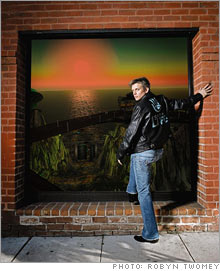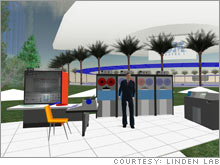Second Life: It's not a gameFortune's David Kirkpatrick reports on why IBM's Sam Palmisano and other tech leaders think Second Life could be a gold mine.NEW YORK (Fortune) -- Last November in Beijing, IBM gathered 2,000 employees, with 5,000 more watching on the web, to unveil a series of global initiatives on digital storage, branchless banking, and the like. During the presentation, CEO Sam Palmisano walked up to an onstage PC, logged onto the online three-dimensional virtual world called Second Life, and took command of the cartoon-like "avatar" that represents him there. He then visited a version of Beijing's Forbidden City built on virtual real estate, dropping by an IBM (Charts) meeting where avatars controlled by employees in Australia, Florida, India, Ireland, and elsewhere were discussing supercomputing. Among the initiatives announced by Palmisano that day: a $10 million project to help build out the "3-D Internet" exemplified by Second Life.
By early January more than 3,000 IBM employees had acquired their own avatars, and about 300 were routinely conducting company business inside Second Life. "The 3-D Internet may at first appear to be eye candy," Palmisano writes in an e-mail interview, "but don't get hung up on how frivolous some of its initial uses may seem." He calls 3-D realms such as Second Life the "next phase of the Internet's evolution" and says they may have "the same level of impact" as the first Web explosion. There's no question that Second Life's initial uses have gotten a lot of media attention in recent months. And indeed, Second Life's admixture of fantasy and reality is intoxicating. The software you download from www.secondlife.com lets you imagine you're stepping inside your PC's screen to inhabit and move about in a brightly colored, three-dimensional world that resembles Grand Theft Auto crossed with Lord of the Rings. Within that digital realm you can go anywhere (though some areas are private). There are stores, beaches, golf courses, bars, ski areas, high-rise office buildings, fantastical anime cities, medieval role-playing regions, and sex clubs - lots and lots of sex clubs. Many people indulge their lascivious fantasies, trading sweet nothings via text while triggering little X-rated animations. Like many new technologies, including videotapes and the Internet itself, much of Second Life's growth appears to be driven by lust for the pleasures of the electronic flesh. None of that is created by Linden Lab, the 110-employee San Francisco company behind Second Life. It's all hatched by the users. Indeed, members invent not only the world but themselves: Each person dreams up his own avatar. A control panel allows you to adjust your avatar's body, including eye color, cheek thickness, pant length, and girth. You can make it resemble your real self, or someone - or something - else. Want to look like Britney Spears? No problem. Perhaps you'd like to be a crocodile with a chef's hat? You can do that too. Once you've designed yourself, you can walk around the virtual world, using the arrow keys on your keyboard. If you'd prefer, you can fly. You see the world on your screen from the vantage point of your avatar. One thing you'll always see: a lot of other avatars. It's a highly social medium. That's a big part of Second Life's allure. If the Web offered people the liberation of communicating with almost anyone, Second Life gives you the chance to meet people in wildly varying contexts, and do it in a body you created. (This may explain why so many avatars appear buff, invitingly dressed, and about 20 years old.) It offers endless social possibilities with people around the globe - text chat is ubiquitous, and voice conversation is coming - and the sort of exploration that keeps its fans glued to their screens for hours. This virtual world - don't call it a game - has become a phenomenon: Second Life, which is free for casual use, has about 334,000 regular visitors. More than 2.6 million have checked it out, a figure that in mid-January was growing by about 20,000 per day. But what's beginning to catch the attention of IBM and other huge corporations is something potentially far more profound than a new online pastime. It's the ability to use Second Life as a platform for a whole new Net - this one in 3-D and even more social than the original - with huge opportunities to sell products and services. Bill Gurley, a venture capitalist with Benchmark Capital, says he invested in Second Life because it's like Microsoft (Charts) or eBay (Charts) - a venue in which thousands of ancillary businesses can sprout. (Gurley, a former Fortune columnist, is now on Linden's board.) The company's backers include some of the world's smartest, richest, and most successful tech entrepreneurs. The chairman and first big outside investor is Mitch Kapor, creator of Lotus 1-2-3, the spreadsheet application that helped begin the PC software revolution. Other investors include eBay founder Pierre Omidyar, Amazon (Charts) CEO Jeff Bezos, and Microsoft chief technology architect (and inventor of Lotus Notes) Ray Ozzie - each credited with a seminal networked product of our age. |
Sponsors
| ||||||||||||||||


